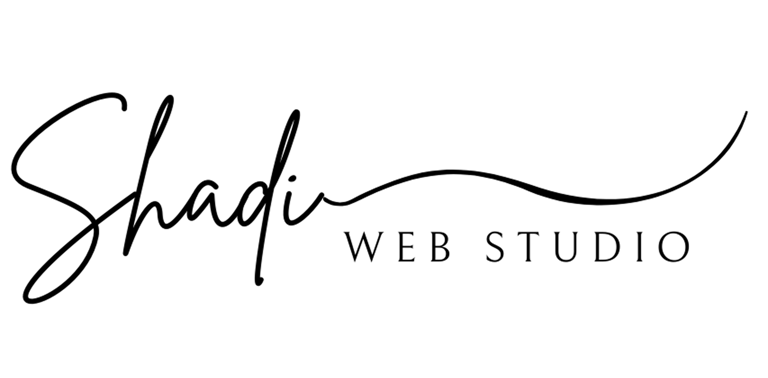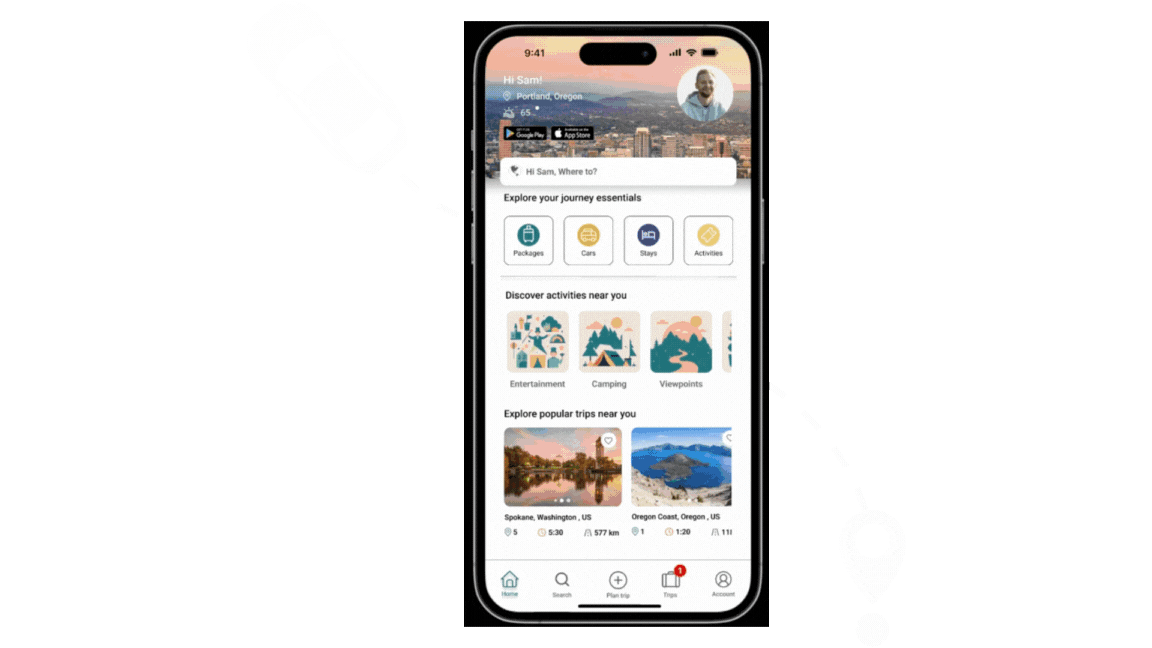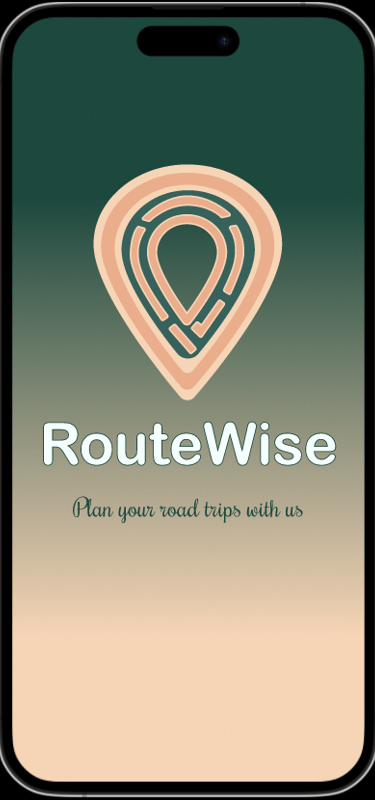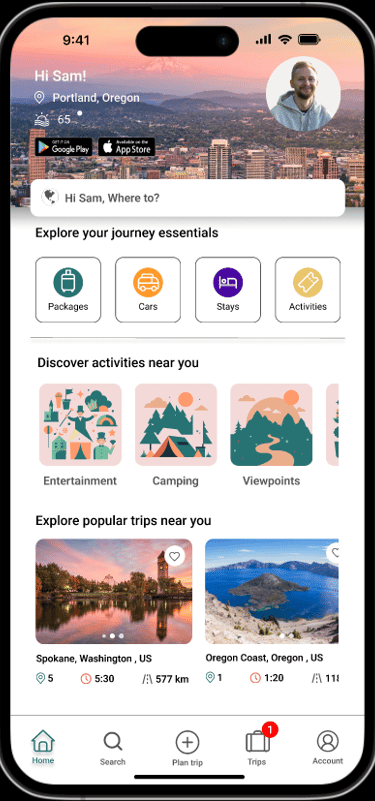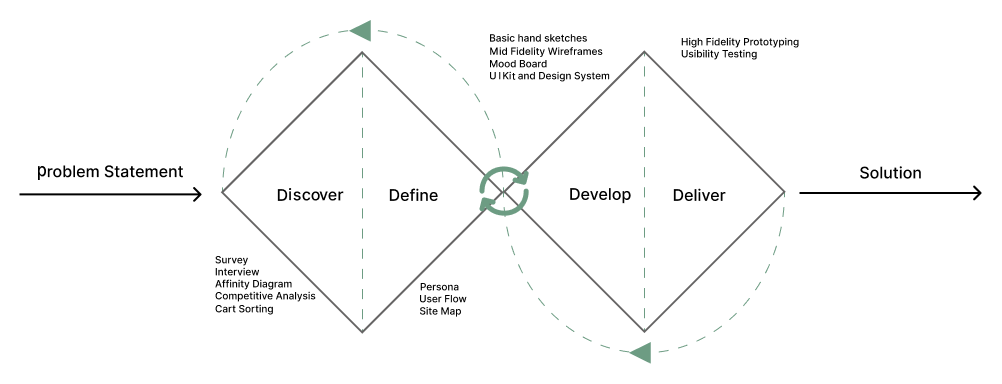RoadWise
A road trip planner from A to Z.
Project Overview
All-in-One Road Trip Planner: Comprehensive tool for planning every aspect of your journey.
Customization: Tailor your trip to suit your preferences and needs.
Budget-Friendly Options: Find affordable transportation and accommodations to create a cost-effective road trip tailored to your budget.
Ease of Booking: Book cars or RVs, accommodations, activities, and tickets online effortlessly.
Flexible Adjustments: Modify your plans on the go to adapt to changing conditions.
Smooth Experience: RouteWise ensures a hassle-free, personalized road trip from start to finish.
RouteWise is a comprehensive, customizable road trip planning platform designed to simplify every stage of the journey. It helps users plan trips based on destination, time, and budget, offering flexibility in choosing routes, vehicles, accommodations, and activities.
Key Features:
Pre-Trip Planning: Users can easily select their route, decide whether to drive their own vehicle or rent an RV, book accommodations, and plan stops, including attractions and activities. The app provides real-time cost assessments and price updates tailored to user preferences.
Real-Time Road Assistance: During the trip, RouteWise offers live road alerts, including weather updates and traffic information, ensuring users can adjust plans if needed.
Post-Trip Features: After the trip, users can share their travel diaries—including photos and highlights—with friends and the RouteWise community.
RouteWise aims to make road trip planning easy, affordable, and enjoyable, while fostering a social community for users to share and discover new experiences.


Target Users
1-All-Inclusive Trip Planners:
Individuals looking for a comprehensive travel experience who want to book a complete package including vehicle rental, route planning, accommodations, and activities.
2-Vehicle Renters:
People specifically interested in reserving a vehicle for their trip, who may want to customize their travel plans around their choice of transportation.
3-Accommodation Seekers:
Users focused on finding and booking suitable accommodations for their stay, whether for a single night or the entire trip, and may also be interested in planning their journey around these reservations.
4-Activity Planners:
Travelers interested in discovering and booking activities along their route, aiming to enrich their journey with engaging experiences and adventures.
Note: Given the limited time available, we considered pre-trip planning as a single package for this case study.
This is a project I worked on while studying at UX-Land School. I collaborated with my colleagues as both a UX researcher and a UI designer.
Due to time constraints, we focused on pre-trip planning as a package. I conducted interviews to understand user needs and contributed to designing a simple platform for customizing and booking road trips. The goal was to make travel planning easy and efficient for users by following these value propositions of business:
Note: In this case study, we concentrated on designing the website for the first target groups
My Role
Designe Thinking
Discover
To understand the users' pain points and develop effective solutions, we employed a comprehensive research approach that consisted of the following methods:
Competitive Analysis
Survey
Interview & Affinity Diagram
Cart Sorting
Interview
For trip planning, we selected a package in this task that includes Road, Vehicle, Activities, and Accommodation. These areas required separate consideration, which we addressed individually during the interview process.
Affinity Diagram
Competitive Analysis


We evaluated 12 online platforms related to road trips, campsites, and RVs, examining fourteen key features. Our analysis revealed that Roadtrippers was the most competitive platform overall, while Outdoorsy (Rv rental portal) and Wanderlog and Tripadvisor (Trip planners) stood out for their affordability and customization options.
Using these insights, we designed a new website that addresses the identified gaps in the market and capitalizes on opportunities for enhancement, focusing on integrating the most valued features while offering improved functionality for users.
Cart Sorting
Some of the observations from Competitive analysis had a direct impact on the contents of the cards that we were creating. Based on the insights gained from the competitive evaluation, we made necessary modifications to the card contents to enhance their effectiveness and relevance.
Then we worked on Cards and their contents again, based on a re-evaluation of the competitive analysis.
We decided to conduct our card sorting using the Optimal Workshop platform. This choice significantly simplified our work, as it enabled us to view the results categorized based on different criteria. For instance, we could easily identify the Categories assigned to each Card and observe the Cards designated for each Category.
Survey
To better understand our target audience and their challenges, we created an online survey and shared it with relevant communities. Within a few days, we received 46 submissions. Based on the responses, we identified four main points, which guided our next steps:
Preference for Car and RV Travel: Many users prefer car or RV trips, so the platform should offer seamless RV rentals and related accommodations.
Comprehensive Planning Tools are Key: Users want cost estimates, interactive maps, route suggestions, and easy accommodation booking—all essential features.
Interest in Outdoor and Adventure Activities: Users are keen on exploring new places and outdoor activities, so it is important to provide selected routes with adventure options and detailed destination information.
Gap for a comprehensive platform: Many still rely on Google Maps for trip planning, which lacks essential features. This platform should offer similar navigation and real-time updates, so users can rely on it for both planning and during their journey.
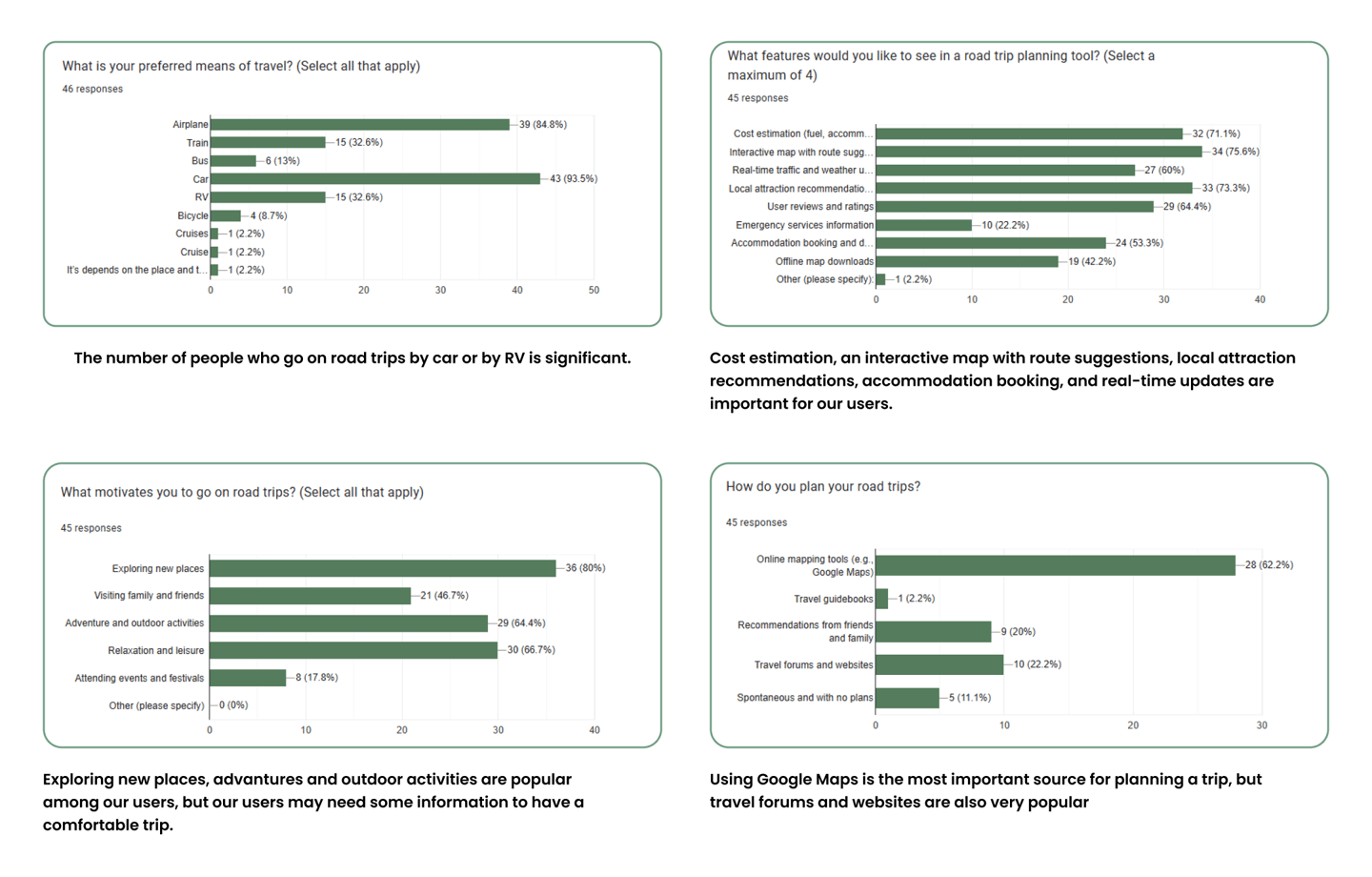

We prefer side roads over main roads and highways for the first two reasons that we enjoy the scenery on the side roads from the villages.
Facilities on the road and road safety are very important to me; I don't prefer remote places.
To choose the route, we always try to make the departure route different from the return route so that we can benefit from different tourist attractions.
I use Google Maps to find places, but sometimes I end up driving long distances only to find no good stops. Planning ahead with apps is helpful, but many have costly subscriptions.
Size/ amenities /reliability. It's important to have a
a vehicle that suits my needs and can handle different terrains.The experience of traveling with an RV car is different because the speed of movement is different, there are restrictions on entering some cities depending on the dimensions of the car and the height, but it is good because wherever you get tired, you have the basic facilities to rest.
Facility of campsite
The opinions of users are very decisive about any sightseeing place of the hotel and restaurant.
A series of information, including emergency contact details, medical information, and information about repair shops suitable for the specific car, is very important and necessary.
Checking the type of facilities for stopping is very important and crucial for me.
Tedious search for suitable dining options and the difficulty in finding places that align with our preferences.
What I expect from an online platform is to show a list of the best places to visit based on my interests and save my time.
Ability to reserve places before travelling specially the crowded places and in a peak time
Accomadation
Road
Vehicle
Activities
Take away: Travelers have varied preferences in route selection, and routes should be designed to accommodate these diverse tastes for personalized trip planning.
Take away: When renting a vehicle, especially an RV, it’s crucial to provide detailed information about the vehicle, including technical specifications and any specific requirements or limitations, so users can make informed decisions from the start.
Take away: Users expect the platform to provide a curated list of places based on their interests, saving them time on searching. They also want information on peak times for attractions, whether natural sites or museums, to help plan their visits better.
Audience top insight
Take away: Users find it crucial to have detailed, up-to-date information about each stop they plan to make. Therefore, all relevant details should be as accurate and comprehensive as possible to meet their needs.
Road Condition
Budgeting
In our research for designing this website, an affinity diagram revealed that Customization was the most important factor for customers, followed by budget, type of vehicle, route, view, and time. These insights can guide the development of the website to ensure it meets customers' needs.
Expectections:
pain points
The main pain points revolve around the challenges of accurately estimating travel costs, managing unexpected expenses, and dealing with high costs for food and accommodation.
Users expect transparency in pricing, detailed cost breakdowns. Flexibility and online tools for managing budgets and travel plans are also highly valued.


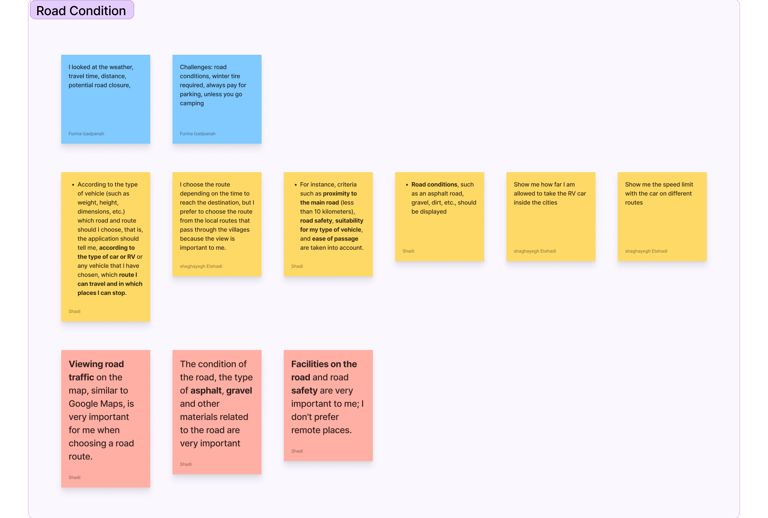

pain points
Lack of information about road conditions, safety, and vehicle-specific routes is a major challenge during road trips.
Providing real-time updates on road conditions, traffic, or detours would improve the journey.
Expectections:
Users want personalized route suggestions (fastest, optimal, scenic) with filters like toll-free or paved roads.
Regular updates during the trip about any road changes or traffic issues are important.


pain points
Size and Comfort Issues: Some users may struggle with choosing the right vehicle size, as they are concerned about comfort and amenities that suit their needs.
Access Restrictions: Certain locations or cities may have restrictions on the size or type of vehicle users can drive, or users may face difficulties in finding parking spaces, limiting their options.
Vehicle/ RV Reservation
Expectections:
Clear Vehicle Information: Users expect detailed information about the vehicles available, including their features, size, and suitability for different travel needs.
Filter Options for Vehicle Selection: Users would like the ability to filter vehicles based on specific amenities (e.g., beds, bathrooms, kitchen facilities) and size to easily choose the vehicle that matches their needs and budget.
Used Popular Applications
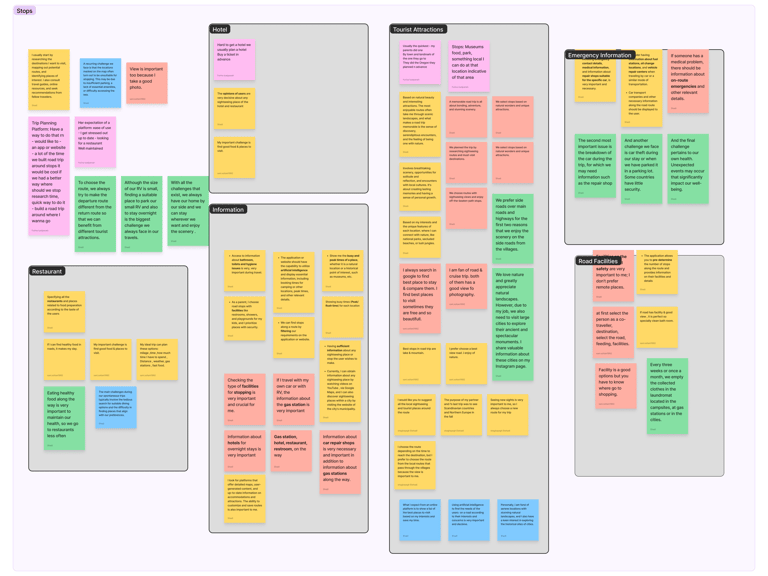

pain points
Limited platforms for finding rest stops: Users currently lack a dedicated platform to easily discover suitable rest stops along routes, often relying on Google Maps as a primary source. However, switching between multiple apps is inconvenient.
Insufficient details on attractions and accommodations: They often struggle to find detailed information on scenic spots, tourist attractions, and accommodations along the way, making planning challenging.
Expectections:
Comprehensive platform for rest stops and attractions: Users want a platform that consolidates information on all possible rest stops, including tourist attractions and accommodations, with thorough details.
Detailed insights on facilities and amenities: They expect information about available amenities like parking, restrooms, safety, and nearby services at each stop, ensuring a smooth and enjoyable journey.
Stops /Stays
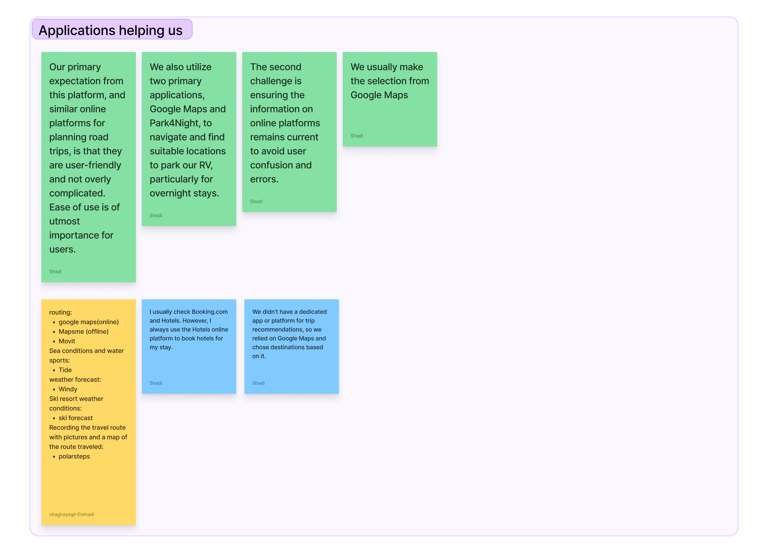

pain points
Current Application Use
Lack of a Dedicated All-in-One Platform: Users mention there is no platform that consolidates everything they need (like stops, attractions, and parking) based on personalized preferences.
Switching Between Apps: Users find it inconvenient to use multiple platforms to get all the necessary information.
Expectections:
Simplicity and User-Friendliness: Users expect the platform to be easy to use and not overly complex.
Up-to-Date Information: It's essential for the platform to keep information current to prevent confusion and errors during trips.
Users mainly rely on Google Maps and Park4Night for navigation, finding parking, and locating suitable spots for RV parking and overnight stays.
Tripadvisor, Expedia, Airbnb, Booking.com, and Wonderlog to find accommodation spots.
Other apps to check the weather, discover local attractions, and find gas or charging stations, but they have to switch between multiple apps.
Define
Our team created a persona for our new project based on the personality traits of the target user, such as Nina Wilson, a busy 35-year-old Designer from Portland who values budget & time in the road trip experience. By tailoring our design decisions to meet her needs and preferences, we can create an engaging and effective user experience that resonates with users like Nina.
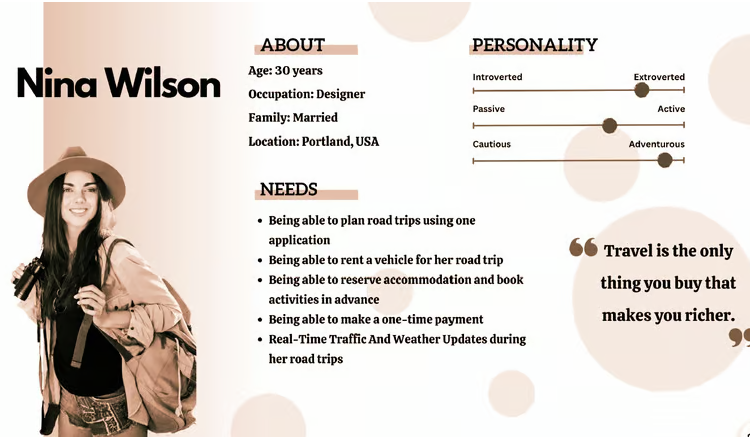

Persona
Site Map
To ensure our information architecture meets user expectations, we conducted 16 open card sorting using the Optimal Workshop platform. After the initial exercise, we developed our first version and iteratively refined it based on user testing and competitive analysis.
Here is our final site map and in this case study, we have concentration on the 'Cakes' Section:
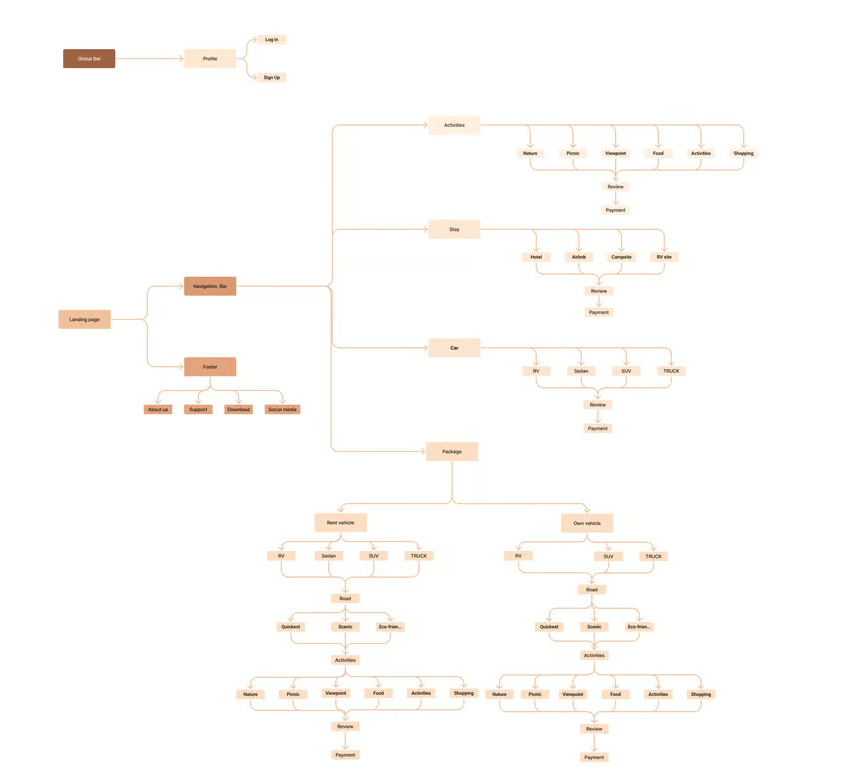

We added a customization task to the user flow for personalized packages, providing a seamless experience for busy professionals like Nina.

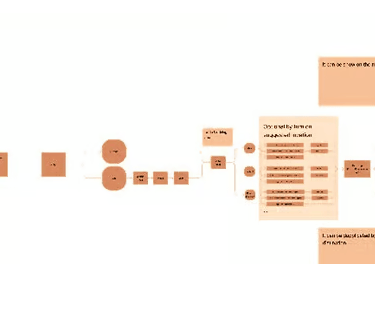
Final User Flow
Develop
Challenges
----------------------------------------------------------------------------------------------------

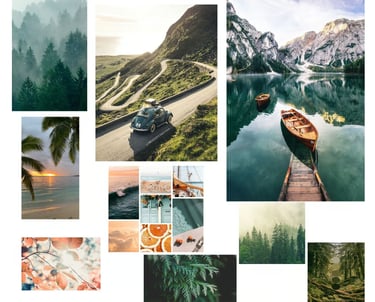
Solutions
----------------------------------------------------------------------------------------------------
----------------------------------------------------------------------------------------------------
----------------------------------------------------------------------------------------------------
xxxxxxxxxxxxxxxxxxxxxxxxxx : ------------------------------------------------------------------------------------------------------------------------------------------------------------------------------------------------------------------------------------------------------------------------------------------------------------
XXXXXXXXX: ----------------------------------------------------------------------------------------------------
XXXXXXXXXX: ----------------------------------------------------------------------------------------------------
XXXXXXX: ----------------------------------------------------------------------------------------------------
Sketches and Wireframes
We initially mapped out our ideation using hand-sketched low-fidelity wireframes, aiding communication within the team during the early design stages. Later, we transitioned to creating low-fidelity wireframes on Figma to visualize page layouts and design direction. These wireframes underwent several iterations before final content development.
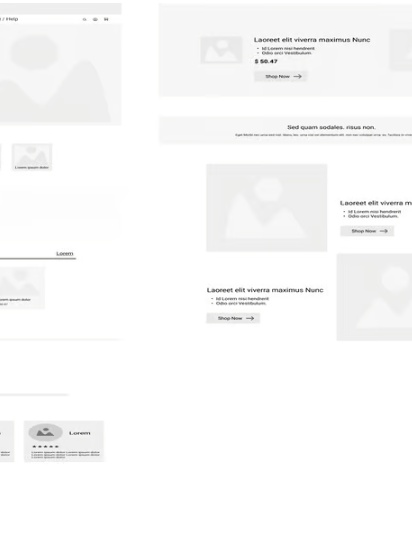





Moodboard
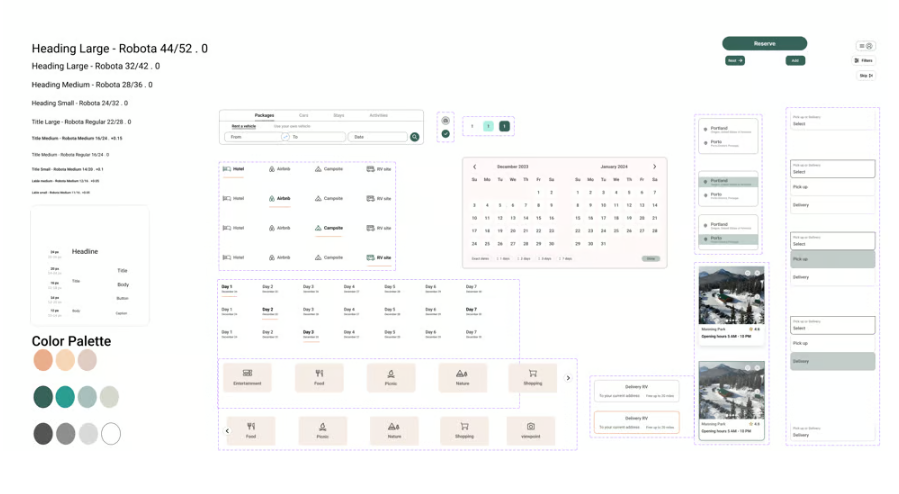

UI Kit
Our UI kit balances casualness with a color palette of dark & light green, light orange & brown tones, modern and easy-to-read fonts.
Deliver
High Fidelity Wireframe
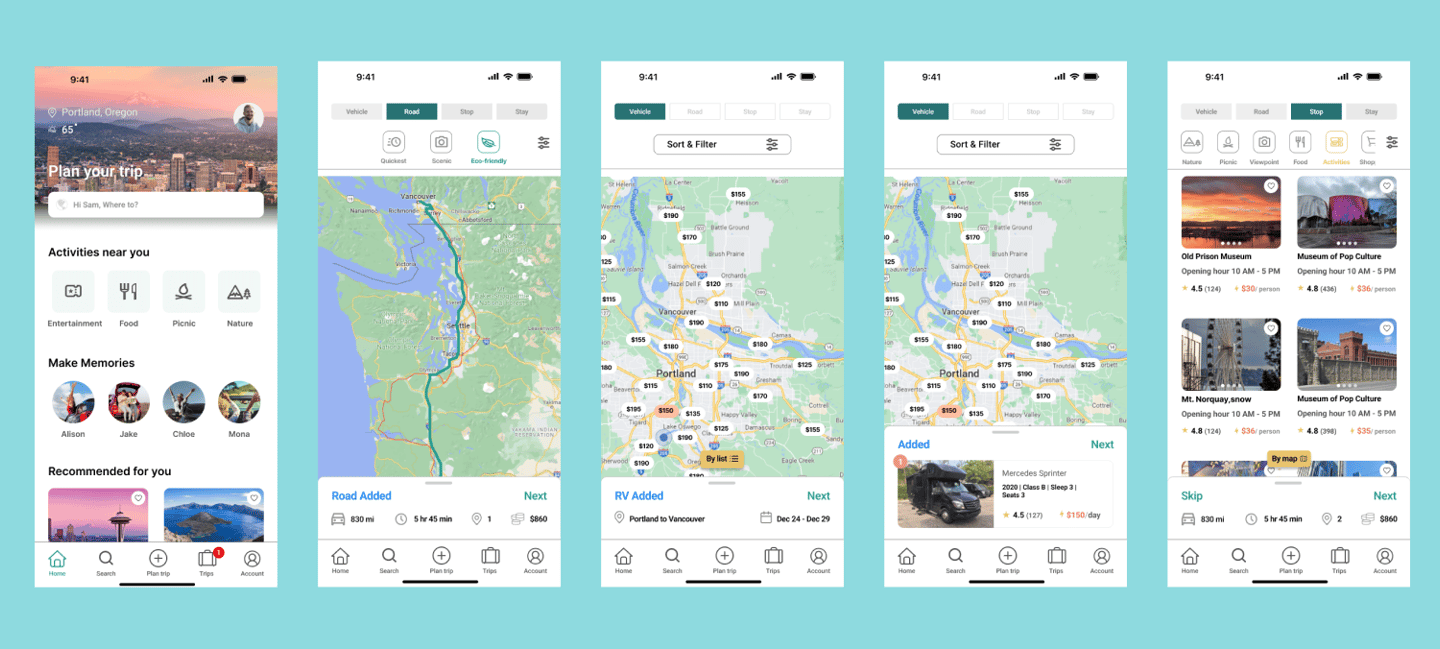

Protoype
Here is the last prototype, displaying what we've achieved through our design process.
Iteration and Usability Test
Throughout the project, we went through multiple iterations, driven by the insights we gained from usability tests. These tests were instrumental in shaping our decisions and constantly enhancing our project.


